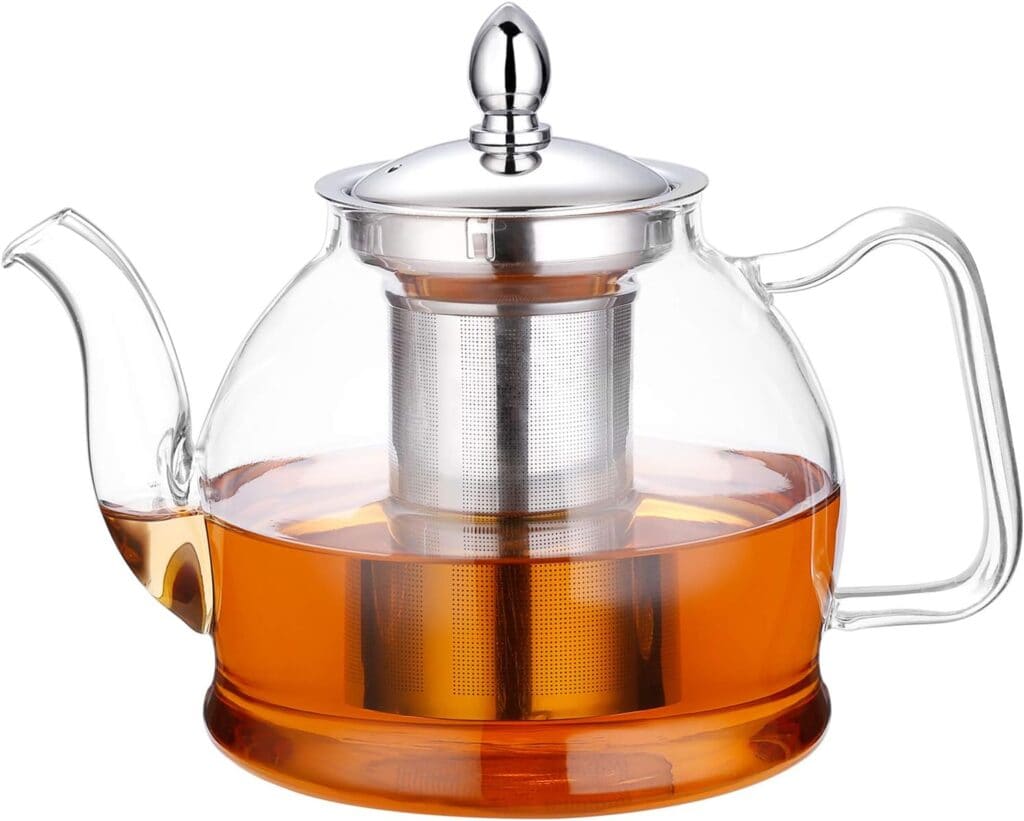Green tea is beneficial for weight control, the immune system, mood, skin and even allergies just to name a few. We know we should drink it, but we don’t all know how to get into the habit of drinking green tea.
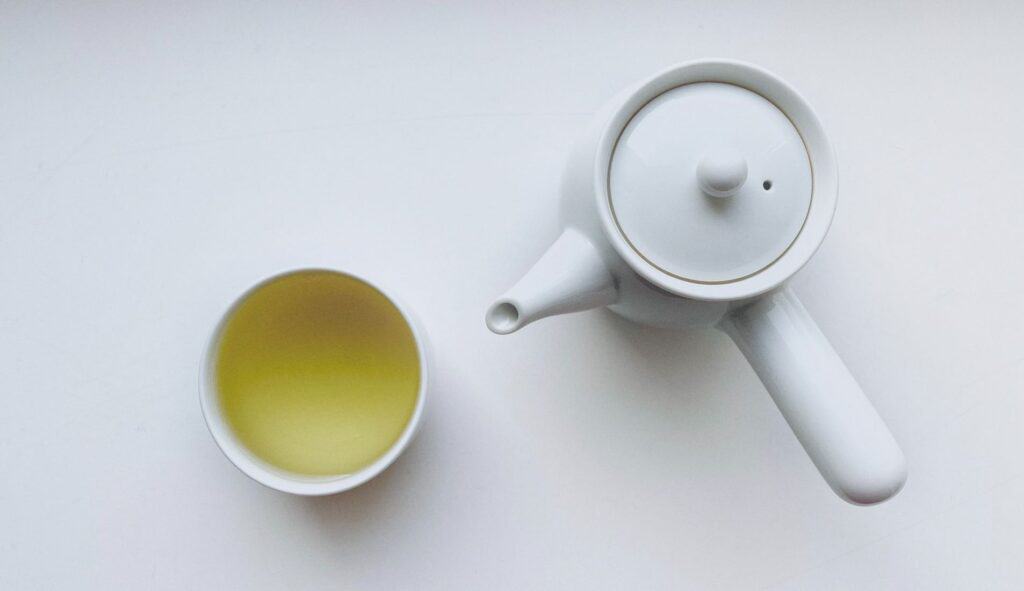
The action step can be hard for those of us who didn’t grow up in a culture that routinely drinks tea, like Japan. No, that southern sweet tea doesn’t count ;). Dr. William Li is one of my favorite green tea advocates.
In his book, Eat to Beat Disease, Dr. Li explains how green tea works with several of our natural defense systems to ward off disease. The research he shares in this book encouraged me to step up my tea game big time.
Many of the green tea drinks you’ll find at the coffee shop or grocery store miss the mark, because they are loaded with sweeteners or not fresh brewed. I’ve embraced green tea for the last 15 years, so I want to share several simple ways to make it, enjoy it and, most importantly, how to get into the habit of drinking green tea.
7 Reasons to Create a Green Tea Habit
There are many claims out there, so we’ll focus on the most supported benefits. I want to note that some of these studies reference actual green tea while some use green tea extracts in a supplement form.
1. Green Tea for Energy Booster/Focus
Green tea contains caffeine, so you can’t really argue that it boosts energy and improves focus.1 It has about half as much caffeine as coffee, so it can be a good substitute for anyone who gets the jitters from the amount of caffeine that’s in coffee.
Green tea offers just enough boost to make you feel alive in the morning or to get you going pre workout, but a single cup likely won’t give you the jitters or a headache.
2. Does Green Tea Burn Fat?
Several studies show that green tea can help a person burn fat potentially aiding in weight loss. Most sources recommend at least 3 glasses a day to reap this benefit.2 You have likely noticed that most natural fat burners contain green tea extract.
3. Green Tea Good for Cardiovascular and Metabolic Diseases
This is closely related to the benefit above. EGCG, Epigallocatechin gallate, found in green tea may improve and/or prevent cardiovascular and metabolic diseases.3 The linked review looks at various studies over the past 25+ years, and the results are positive.
4. Green Tea for Acne
A 2017 study suggests that topical application and potentially the ingestion of green tea may help to reduce sebum production. Sebum is an oily material produced by your body’s sebaceous glands that clogs pores.4 Long story short, fewer clogged pores, equals less acne—this is why you sometimes see green tea infused products in the beauty aisle.
5. Green Tea Reduces Stress
Green contains the amino acid L-theanine, which is known to reduce stress and relax one’s mood.5 A double blind study used a L-theanine nutrient drink to measure cortisol responses in participants. The findings supported the anti-stress effects of L-theanine.

This post contains affiliate links, I may earn a small commission on qualifying purchases.
6. Green Tea Supports Immunity
Some research shows that a component of green tea naturally increases regulatory t-cells, which play an important role in immune function.6 This could potentially aid in some autoimmune conditions. Green tea is full of powerful antioxidants vitamins, which are necessary for an effective immune response making it good for the immune system in more ways than one.
7. Green Tea Improves Allergies
Methylated catechin, an active ingredient in green tea, can improve some allergic reactions. A Japanese study gave participants green tea for 3 months during their pollen season, and the results showed improvement in their allergies compared to the placebo group.7
My Allergy Story
This is certainly no double-blind study, but I want to share my allergy story. I had pretty significant allergies as a teen and young adult and did all of the typical popular things at the time including allergy shots, nasal sprays, OTC allergy medications, etc.
In my late twenties, I cleaned up our diet and started drinking green tea (this happened at the same time) my allergies nearly vanished. I rarely had any allergy symptoms, and this lasted for quite a few years.
Fast forward to 2017 when we moved into a new home, and I started drinking coffee in place of my green tea, my allergies returned with a vengeance including itchy eyes, which I had never experienced (highly do not recommend).
At first, I blamed the move. I tested for mold and radon, had the carpets and air ducts cleaned and purchased an air purifier for the main living space. My allergies got a little better, but I still needed allergy meds from time to time, which I had been able to go without for about eight years.
A couple of years ago, I happened to read an article about green tea improving allergies, and I realized I had almost totally dropped my tea habit when I adopted coffee and that it was the exact same time my allergies went berserk.
I immediately got back on the wagon, and within a month or so my allergies improved significantly. Admittedly, this could all be a coincidence, but it definitely convinced me. I drink at least one glass of green tea each day and aim for two during allergy season.
Now, let’s dive into some ways you can get in the habit of drinking green tea!
How to Drink Green Tea Using Tea Bags
I’ll start with the easy button way, and the way I drank green tea for many years. That is to buy boxes of store-bought tea bags that you simply add to hot water. You want to choose an organic, trust-worthy brand to avoid pesticides.
Many teas are imported from China, so testing is not always reliable. Cheap tea bags also usually contain plastic, which you don’t want especially since they will be submerged in boiling water.
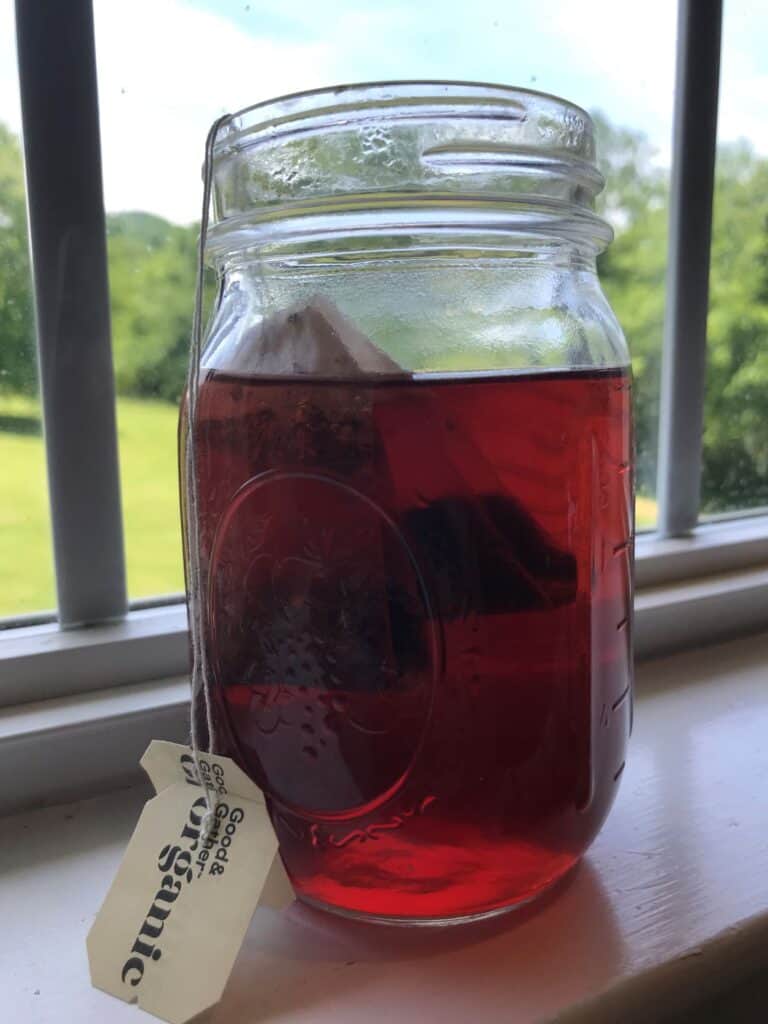
Some of my favorite brands are Numi and Traditional Medicinals. You can find them at most grocery stores as well as on Amazon. Most organic brands should have unbleached, plastic-free tea bags as well but be sure to double check.
Tea bags are great to if you want to drink green tea at work or on the go—you can just heat up a mug of water in the microwave and add your tea bag to the hot water. If you are dining out, you can add your tea bag to a cup of hot water.
When I was home, I boiled water in a tea kettle then poured it over my tea bags in a mason jar or mug. I have also used the microwave method many times over the years when I worked in an office. It takes all of 2 minutes to prepare a cup of tea that way.
While tea bags are not the absolute best way to drink green tea, they were my go-to for many years due to convenience. Many of you may be in the same boat. It helped me drink much more tea than I would have otherwise.
How to Drink Green Tea Using Loose Leaf Green Tea
To maximize nutrients and eliminate tea bags, you can brew loose leaf tea by the cup or by the batch. This is how I drink my tea these days. Brewing loose leaf tea is likely the most healthful way to enjoy green tea.
Rose Mountain Herbs and Full Leaf Tea Co. are my favorite place to order loose leaf tea from. Both companies offer a wide selection of organic loose-leaf teas. Most of the products are organic, non-GMO products grown by sustainable farming practices.
To brew loose leaf tea, you need a tea kettle and some type of strainer or infuser to brew the tea. Stainless steel and glass options are usually good choices. Here are a few products to consider:
Hario Glass Teapot
I own this sweet little Japanese Hario Glass Teapot and love it. It makes just enough tea for two or one person who really loves tea (me!). Admittedly, when I ordered it, I thought it could be used on the stovetop. I even tried once, but thankfully I googled instructions before I shattered it!
I already own a stainless-steel tea kettle that I use daily for coffee, so I kept the Hario teapot and just use the pour over method as intended. If you want a glass teapot that can go on the stovetop. Keep reading.
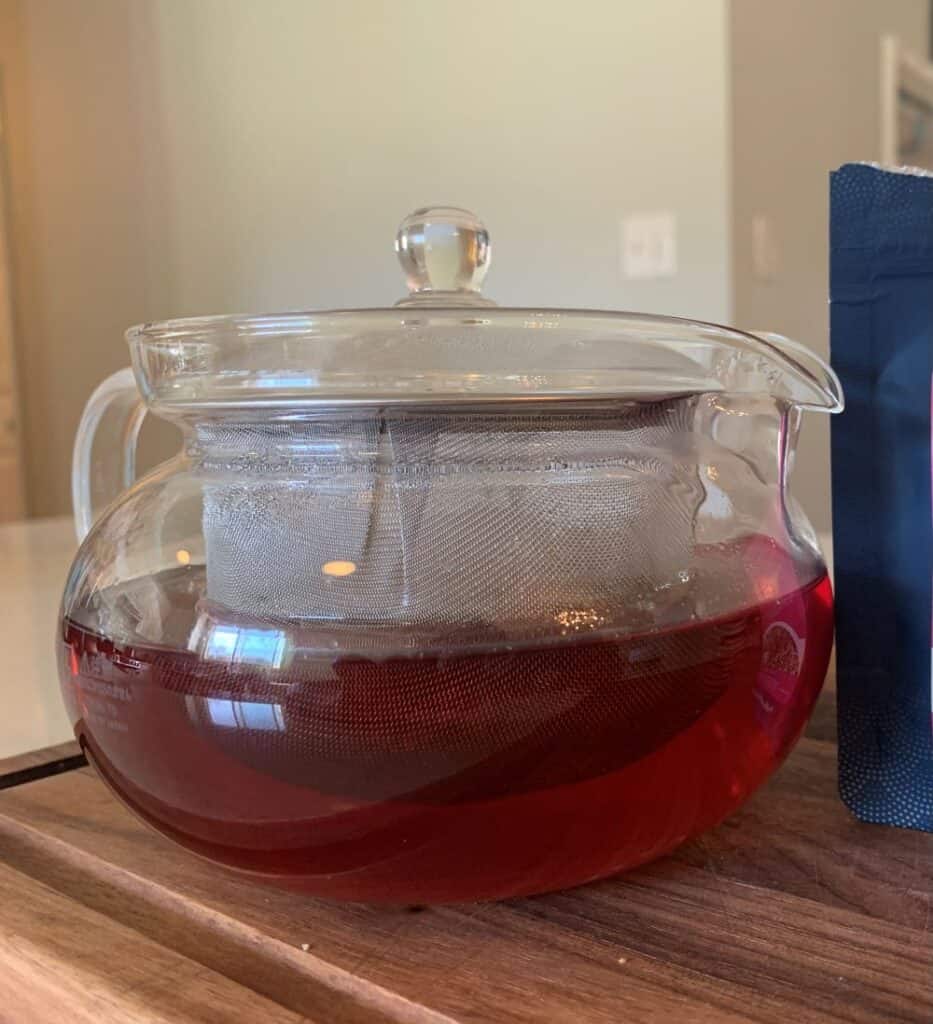
Hiware Glass Teapot
This Hiware Glass Teapot can go directly on the stovetop, which is appealing. While I haven’t tried this one, with 18K excellent reviews, it’s likely a fantastic little teapot, and if you don’t already have a kettle then you save a step and save space.
How to Make Green Tea Taste Better
I have an entire blog post dedicated to this: How to Make Green Tea Taste Better Without Sugar.
If you are drinking pure green tea (no sweeteners, no flavors), it’s definitely an acquired taste. I’ve had lots of people tell me they don’t like the taste of green tea this way. I taught myself to drink it plain for years, but I realize that’s not everyone’s cup of tea (ha!).
A few years ago, I discovered a simple trick that makes green tea taste better. The trick is adding raspberry (or any berry) or hibiscus tea to the green tea. You can use this method with tea bags or loose leaf tea.
If you don’t care for hot tea, you can always cool it in the fridge or with ice. The fruity flavor really adds to the taste without adding sugar or another sweetener, but a dab of honey wouldn’t hurt either. And let’s not overlook the power of a squeeze of lemon!
What is Matcha Green Tea?
Shade-grown green tea is ground into a powder to make matcha. The entire leaf is used making it even more potent and beneficial, and you can drink matcha by adding it directly to hot water. Some people add milk or sweeteners to enhance the flavor.
Matcha powder can be a really easy way to incorporate green tea into your diet. Since it’s already in a powder form, you don’ have to brew it. My favorite way to drink matcha tea is to blend a little into my morning smoothie.
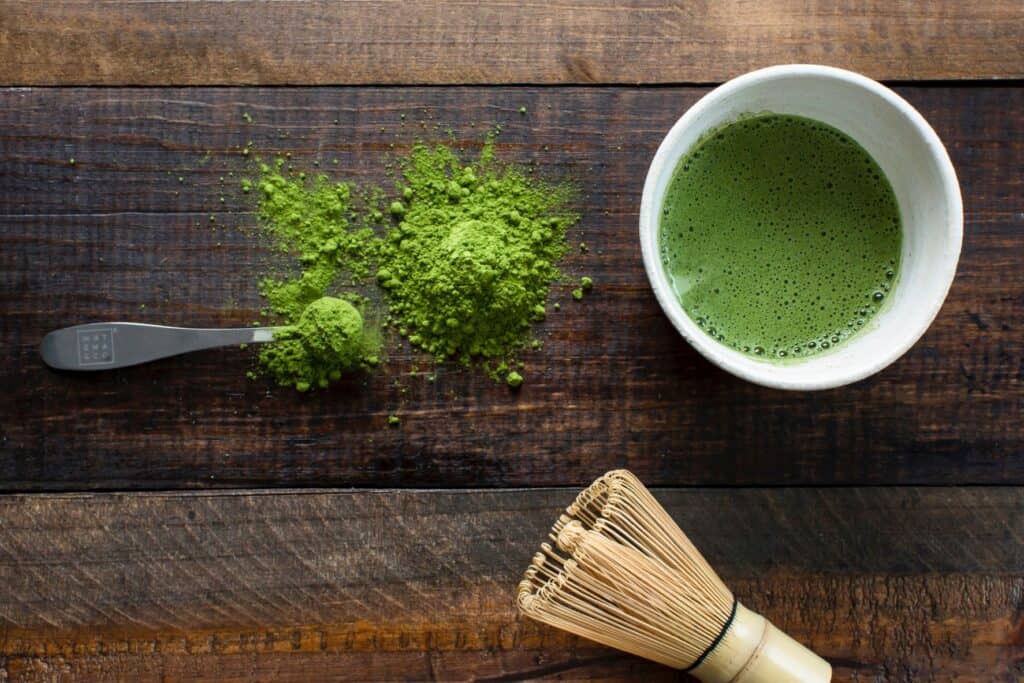
A serving is typically 1-2 tsp. If you are caffeine sensitive, keep in mind that it contains more caffeine than regular green tea, so you may want to start with ½ a tsp.
Matcha has a subtle, fresh flavor, so it only adds a hint of green tea taste to your smoothie and goes well with most green smoothie recipes IMHO.
Are Bottled Green Teas Healthy?
Bottled tea is an excellent choice if you are trading out soda or another sugary healthy beverage or taking baby steps to incorporate green tea into your routine. I like to grab a bottled tea on occasion as a little treat or a gallon jug when we have company coming over—we all need to push the easy button from time to time.
Unfortunately, with each step of processing, you tend to lose some nutrients. Bottled teas also often have added sugar, flavors and preservatives to watch out for. If you choose to buy bottled tea or enjoy it on occasion, look for a tea with very low or no added sugar or other sweeteners. Flavorings are o.k. if they naturally sourced, and a glass bottle rather than plastic is ideal.
The same goes for green tea drinks at say Starbucks. Unfortunately, many contain junky additives or are made from some type of instant powder, Be sure to ask for specifics if you want to reap the benefits of pure green tea.
Conclusion
I hope this post helped you by providing some easy ways to drink green tea and, more importantly, how to get into the habit of drinking green tea. If tea is not your thing, I have a coffee post that you may like better. Thankfully, coffee also carries amazing health benefits. Happy sipping!
Sources:
1.) Mancini, E., Beglinger, C., Drewe, J., Zanchi, D., Lang, U. E., & Borgwardt, S. (2017). Green tea effects on cognition, mood and human brain function: A systematic review. Phytomedicine : international journal of phytotherapy and phytopharmacology, 34, 26–37. https://doi.org/10.1016/j.phymed.2017.07.008
2.) Michelle C Venables, Carl J Hulston, Hannah R Cox, Asker E Jeukendrup, Green tea extract ingestion, fat oxidation, and glucose tolerance in healthy humans, The American Journal of Clinical Nutrition, Volume 87, Issue 3, March 2008, Pages 778–784, https://doi.org/10.1093/ajcn/87.3.778
3.) Eng, Q. Y., Thanikachalam, P. V., & Ramamurthy, S. (2018). Molecular understanding of Epigallocatechin gallate (EGCG) in cardiovascular and metabolic diseases. Journal of ethnopharmacology, 210, 296–310. https://doi.org/10.1016/j.jep.2017.08.035
4.) Saric, S., Notay, M., & Sivamani, R. K. (2016). Green Tea and Other Tea Polyphenols: Effects on Sebum Production and Acne Vulgaris. Antioxidants (Basel, Switzerland), 6(1), 2. https://doi.org/10.3390/antiox6010002
5.) White DJ, De Klerk S, Woods W, Gondalia S, Noonan C, Scholey AB. Anti-Stress, Behavioural and Magnetoencephalography Effects of an l-Theanine-Based Nutrient Drink: A Randomised, Double-Blind, Placebo-Controlled, Crossover Trial. Nutrients. 2016; 8(1):53. https://doi.org/10.3390/nu8010053
6.) Wu D. (2016). Green tea EGCG, T-cell function, and T-cell-mediated autoimmune encephalomyelitis. Journal of investigative medicine : the official publication of the American Federation for Clinical Research, 64(8), 1213–1219. https://doi.org/10.1136/jim-2016-000158
7.) Masuda, S., Maeda-Yamamoto, M., Usui, S., & Fujisawa, T. (2014). ‘Benifuuki’ green tea containing o-methylated catechin reduces symptoms of Japanese cedar pollinosis: a randomized, double-blind, placebo-controlled trial. Allergology international: official journal of the Japanese Society of Allergology, 63(2), 211–217. https://doi.org/10.2332/allergolint.13-OA-0620
